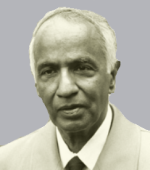Theoretical physicist Subrahmanyan Chandrasekhar FRS lived and worked in America for his whole career (19 October 1910–21 August 1995). Together with William A. Fowler, he was awarded the 1983 Nobel Prize in Physics for his "...theoretical studies of the physical processes important to the structure and evolution of the stars." Many of the existing theoretical models of the final evolutionary stages of big stars and black holes were produced by his mathematical study of stellar evolution. Many ideas, organizations, and technologies bear his name, including as the Chandrasekhar limit and the Chandra X-Ray Observatory.
During his lifetime, Chandrasekhar worked on a wide range of physics-related issues, advancing our knowledge of white dwarfs, stellar dynamics, stochastic processes, radiative transfer, the quantum theory of the hydrogen anion, hydrodynamic and hydromagnetic stability, turbulence, equilibrium and the stability of ellipsoidal figures of equilibrium, general relativity, the mathematical theory of black holes, and the theory of colliding gravitational waves. He created a theoretical explanation of the structure of white dwarf stars at the University of Cambridge that takes into account the relativistic change of mass with the velocity of the electrons that make up their degenerate substance. He demonstrated the Chandrasekhar limit, which states that a white dwarf's mass cannot be greater than 1.44 times that of the Sun.
From 1952 through 1971, he served as The Astrophysical Journal's editor. From 1937 until his passing in 1995 at the age of 84, he served as a member of the Chicago faculty as the Morton D. Hull Distinguished Service Professor of Theoretical Astrophysics.
Early Life And Education
In a Tamil Brahmin family, Chandrasekhar was born in Lahore, Pakistan, on October 19, 1910, during the British Raj. His parents were Sita Balakrishnan (1891-1931) and Chandrasekhara Subrahmanya Ayyar (1885-1960), who was serving as the Northwestern Railways' deputy auditor general at the time Chandrasekhar was born. Rajalakshmi and Balaparvathi were his two older sisters. Vishwanathan, Balakrishnan, and Ramanathan were his three younger brothers. Sarada, Vidya, Savitri, and Sundari were his four younger sisters. The Indian physicist and Nobel laureate Chandrasekhara Venkata Raman was his paternal uncle.
Chandra's mother is credited with igniting his academic curiosity at a young age. She was passionate about intellectual pursuits and had translated A Doll's House by Henrik Ibsen into Tamil. In 1916, the family relocated from Lahore to Allahabad, and in 1918, they made their ultimate home in Madras.
Philosophy Of Systematization
He claimed that the primary motivation for his scientific work was systematization and that it was driven by a desire to contribute to the advancement of many scientific fields to the best of his ability. "What a scientist tries to do fundamentally is to choose a particular domain, a particular aspect, or a particular detail and see if that takes its proper place in a general scheme that has form and coherence; and, if not, to seek further information that would help him to do that."
Chandrasekhar created a special method for mastering a variety of physics and astrophysics topics; as a result, his professional life can be separated into different eras. He would thoroughly research a subject, write multiple papers on it, and then produce a book outlining the key ideas. He would then change careers for the following ten years, repeating the cycle. He therefore worked on stellar dynamics, including the theory of Brownian motion, from 1939 to 1943 after studying stellar structure, including the theory of white dwarfs, from 1929 to 1939. From 1943 to 1950, he focused on the theory of radiative transfer and the quantum theory of the hydrogen ion negative.
From 1950 through 1961, there was continued research on turbulence, hydrodynamic stability, and hydromagnetic stability. He investigated general relativity in the 1960s, as well as the equilibrium and stability of ellipsoidal figures of equilibrium. He researched the mathematical theory of black holes from 1971 to 1983 before focusing on the theory of gravitational waves clashing in the late 1980s.
Nobel Prize
For his research on the physical processes crucial to the construction and evolution of stars, Chandrasekhar received a portion of the 1983 Nobel Prize in Physics. The citation that only emphasized Chandrasekhar's earliest work offended him since he felt it minimized his lifetime of accomplishments. Nevertheless, he accepted the honor. With William A. Fowler, he shared it.

